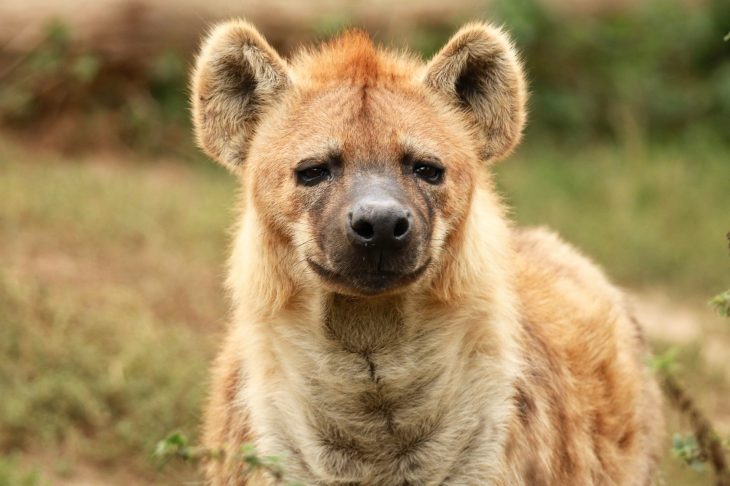
Hyenas or hyaenas are perhaps most famous for their uncanny laughter and their tendency to scavenge leftovers from larger predators. Thriving throughout Africa and some parts of Asia, these fierce animals roam great distances at night to find food. Their aggressive tendencies are no laughing matter; these doglike carnivores sometimes attack humans and even rob their graves. Although their reputation makes them hard to love, there is more to these curious animals than meets the eye. So learn more about them with these fascinating hyena facts.
- Hyenas likely evolved in the jungles of Eurasia during the Miocene epoch, around 22 million years ago.
- Spotted hyenas are the largest hyena species, and they typically stand as tall as 28 to 36 inches (70 to 91.5 cm) at the shoulder.
- Brown hyenas have the shortest lifespan of all hyena species. Other hyena species may be as old as 20 to 25 years, but brown hyenas only live up to 15 years.
- They have a strong sense of hearing; hyenas can hear predators at distances of up to six miles (10 km).
- Spotted hyenas are famous for their antagonistic role in the 1994 Disney film The Lion King.
- All hyenas belong to the family Hyaenidae.
- They are native to Africa, Southwest Asia, and India.
- Hyenas are carnivorous mammals.
- They have rich manes, rounded ears, and bushy tails.
- Their forelegs are longer than their hind legs.
- The distinct markings on their fur help the hyenas blend in with their surroundings.
- Hyenas are mostly nocturnal, but they may also be active throughout early mornings.
- Spotted hyenas are among the most common large carnivorous mammals in Africa.
- Of all hyena species, the striped hyena has the largest range.
- Hyenas are highly adaptable and can live in various types of environments such as deserts, forest edges, savannas, coastal areas, and woodland areas.
- The striped hyena is the national animal of Lebanon.
- One hyena researcher sued Disney for its portrayal of hyenas as ugly, cowardly, and dim-witted animals.
- They mark their territories using secretions from their anal pouches. These odorous secretions are often referred to as “hyena butter”.
- Most scientists refer to a group of hyenas as a clan, but some may call it a cackle of hyenas.
- The Greek author and philosopher Pliny the Elder once stated that hyenas could imitate human voices.
There are four living species of hyena.
The family Hyaenidae only has four extant species within three genera. These living hyena species include the spotted hyena (Crocuta crocuta), the striped hyena (Hyaena hyaena), the brown hyena (Hyaena brunnea), and the aardwolf (Proteles cristata).
The four hyena species differ by appearance, size, behaviors, and geographic range. Spotted hyenas are the largest species and have the widest range of all hyenas, while aardwolves are the smallest, and brown hyenas have the smallest range. Striped hyenas, brown hyenas, and aardwolves have striped patterns on their fur, while spotted hyenas have a spotted hide. Among all the hyena species, brown hyenas are the rarest.
Hyenas can be classified into two main types: dog-like hyenas and bone-crushing hyenas.
Around 10 to 14 million years ago, the hyena family split into two distinct groups, and these are the dog-like hyenas and the bone-crushing hyenas. Among the two, descendants of the bone-crushing hyenas are now more prevalent.
Dog-like hyenas were much smaller and more nimble-bodied than bone-crushers. Their appearance bore a strong similarity with other dog-like carnivores such as wolves and jackals. Dog-like hyenas thrived for millions of years before reaching their decline due to climate change and competition with canids. Today, only the aardwolf remains as their only descendant.
Bone-crushing hyenas were more robust in build and specialized in cracking bones as their name suggests. These bone-crushers scavenged on the remains of large animals hunted by saber-toothed cats. The spotted, striped, and brown hyenas are all descendants of bone-crushing hyenas.
Despite looking and acting similar to dogs, hyenas are more closely related to cats.
Superficially, hyenas look a lot like wild dogs. They have pointed dog-like snouts, as well as blunt and non-retractable claws. Hyenas also cannot climb trees, preferring to chase after prey instead of stalking and ambushing as wild cats do. Like wild dogs, hyenas also catch prey with their mouths instead of their claws.
Although they look and act similar to dogs, they are actually more closely related to cats when it comes to genetics and ancestry. Hyenas are part of the suborder Feliformia, which is a taxonomic group that encompasses all cat-like carnivores. This suborder includes tigers, lions, civets, meerkats, and even the humble house cat. Hyenas also exhibit many feline behaviors such as grooming and parental and territorial habits. Now that is certainly one of the most surprising hyena facts!
They have large and complex social groups.
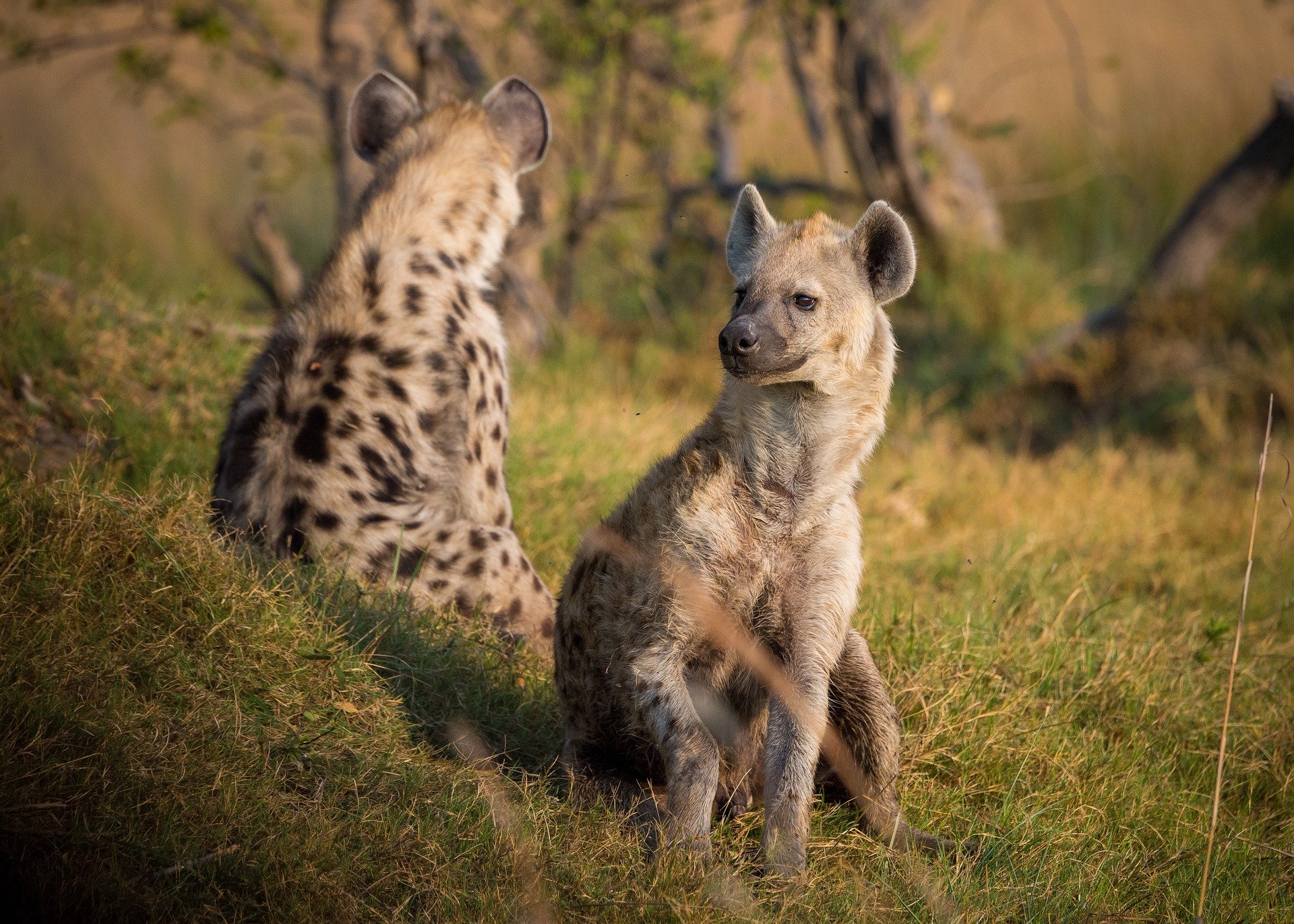
While striped hyenas and aardwolves tend to live in small groups, brown hyenas and spotted hyenas are remarkably social animals. Brown hyenas have social hierarchies similar to those of wolves and tend to live with their extended families. Spotted hyenas, on the other hand, have a more complex social structure.
Among all animals in the order Carnivora, the spotted hyenas have the largest social group sizes and the most complex social behaviors. Their clans can include up to 80 individuals, and they follow a social hierarchy. Within their clans, they share meals and a communal den, and they work with each other to defend their territories.
The complexity of their social groups is even comparable to the groups of some primates. They have a social hierarchy with certain ranks, and these ranks are not based on who is the biggest or strongest. Instead, they form ally networks or coalitions which heavily influence their social ranks. Spotted hyenas can recognize each other’s ranks and whether or not they are part of the same clan. Interestingly, they can even tell if a certain member of the clan is unreliable.
Female hyenas are more dominant in their social circles than males.
When it comes to social hierarchies, female spotted hyenas rule. Matriarchs or alpha females are the leaders of hyena clans, and they have a priority over meals and reproduction. Female hyenas are larger, more aggressive, and more dominant than males. Even the highest-ranking male falls lower in the hierarchy than the lowest-ranking female.
The female cubs tend to stay within their original clans, while males must find another clan to join when they reach maturity. When they find a new clan to join, they must spend a significant amount of time gaining the favor of females. Even when they find a female that is smaller than them, they must show submissive behaviors towards them.
Female spotted hyenas have unusual genitals.
One of the most shocking hyena facts is that the genitals of female spotted hyenas are rather strange. In most mammals, the males have penises while the females have vaginal openings. Spotted hyenas, however, are exceptional because the females of this species do not have vaginal openings. Instead, they have pseudo-penises that closely resemble the genitals of the males.
The pseudo-penis is an enlarged clitoris that has a single opening called the urogenital canal. The female hyenas use this to urinate, mate, and give birth. This structure is even capable of having erections similar to the male genitals. To top it off, their labia are fused together to form pseudo-scrotums. Because of this, female and male spotted hyenas look hugely similar. The distinguishing features of the female genitalia are that they are thicker, shorter, and rounder at the tips.
When the pseudo-penises are flaccid, they retract into the abdomen and only the coverings are visible. Males can only mate with the females when they retract their pseudo-penises. The presence of pseudo-penises makes it physically impossible for males to mate with females unless the female consents. However, the drawback is that these structures make giving birth a rather painful process. When female hyenas give birth, the pseudo-penises swell and rupture to allow the offspring to exit.
The hyena “laugh” is actually not a sign of happiness.
Among the most well-known hyena facts is that they have recognizable calls that resemble human laughter. Spotted hyenas are remarkably vocal animals, and they communicate with an extensive range of calls. These calls include giggling, groans, growls, grunt-laughs, and whoops. Hyenas let out loud, lower-pitched calls to indicate aggression, while they make high-pitched calls to communicate submission.
Laughing in hyenas does not indicate fun, however. Spotted hyenas use the signature laugh or giggle as a signal of high stress, often during aggressive encounters and competition. Hyenas also use vocalizations to recognize intruders and clan members. Each spotted hyena has a signature “whoop” which other clan members can recognize, and their calls can indicate their rank and age.
They are intelligent animals.
Although the film The Lion King depicts hyenas as rather dim-witted animals, they are actually quite intelligent. The intelligence of spotted hyenas is particularly impressive, rivaling even that of chimpanzees and other primates. They have superior problem-solving skills and can even teach skills and maneuvers to inexperienced hyenas.
This unique intelligence is what allows them to form complex social relationships, and it also helps them coordinate their moves during hunting. Hyenas can also plan their hunting strategies, avoid traps, and deceive other hyenas. Certainly some of the most impressive hyena facts.
Spotted hyenas are efficient hunters.
Despite being popular as scavengers that feed on dead animals, spotted hyenas are also remarkably efficient hunters. Researchers found that they hunt as much as lions, and 70% of their diet consists of direct kills rather than carrion. These hyenas hunt by sight and form hunting packs consisting of two to five individuals.
The most common prey for hyenas include wildebeests, zebras, Thomson’s gazelles, kudu, impalas, and topi. Hyenas prefer taking down young and old prey, especially those who are alone or are behind a herd.
Hunting zebras can be dangerous for hyenas because of their sheer aggressiveness and anti-predator tactics. Because of this, hyenas have to rely on different methods of hunting. They form larger groups when hunting zebras, ranging from 10 to 25 hyenas. The hyenas move in tight bunches to trap the zebra and attempt to dodge its attacks.
Their bite force is impressively powerful.
Hyenas (except for the aardwolf) have large, muscular jaws that can deliver powerful bites. The spotted hyena has an especially strong bite, delivering a pressure of up to 1,140 pound-force per square inch (80 kgf/cm2). Their bite force is 40% greater than the bite of leopards and is also stronger than the bites of brown bears. The bite of one particular hyena even delivered an astonishing 4,500 newtons of force. Truly one of the most outstanding hyena facts.
They can digest bones.
The powerful bites of bone-crushing hyenas are enough to crush bones, as the name suggests. As scavengers, hyenas evolved the ability to not just crush and swallow bones but to fully digest them. Their digestive systems can extract all of the bones’ organic components, not just its marrow. Hyenas then excrete all of the inorganic matter in the bones, making their feces a powdery white mass that are quite visible from a distance.
Spotted hyena cubs are born with their eyes already open.
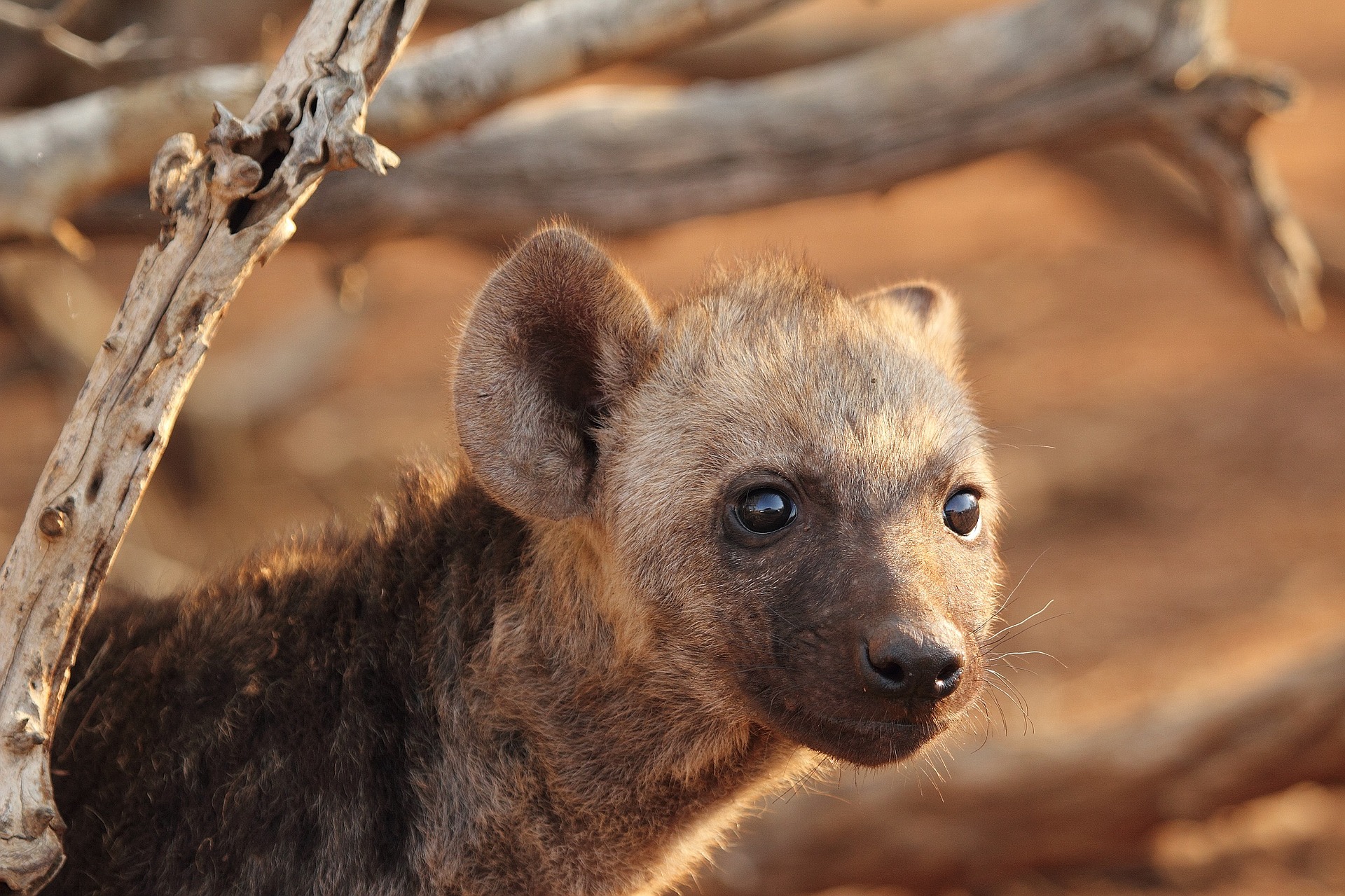
Unlike cats, dogs, and a number of other mammals, spotted hyena cubs are not born helpless and with their eyes and ears shut. They have their eyes open at birth and already have a set of small teeth. These cubs can already process solid food at about three months of age.
Baby hyenas have to fight for their survival.
The life of a spotted hyena cub is off to a rough start. Spotted hyenas typically give birth to two cubs per litter, although litters of up to four cubs occur in rare cases. The mothers only have two nipples, however, so the cubs need to fight for their survival. They aggressively fight their siblings, especially those of the same sex as them. This aggressive behavior makes up about a quarter of hyena deaths in their first month.
Hyenas sleep in dens.
All hyena species make dens where they sleep, give birth, and nurse their young. They often dig their own dens in their territories, but they may also use the dens of other animals such as warthogs, aardvarks, wolves, and porcupines. Hyena dens often have bare patches or leftover bones near the entrance.
In spotted hyenas, communal dens serve as the central point of their social lives. They may change their denning sites regularly or use the same site for several years. Other times, they may even use different den sites at the same time. Despite having communal dens, hyenas often just take care of their own offspring and do not participate in the care of other cubs. In the Kalahari, however, researchers observed communal care during one difficult period.
Hyenas can be great parents.
One of the most unexpected hyena facts is that they can be great parents. The male parents of brown hyenas, striped hyenas, and aardwolves assist in the care of their young. In spotted hyenas, however, the males do not participate in parental care.
Still, spotted hyena mothers invest a significant amount of energy in rearing their cubs. These caring mothers continue to nurse their cubs for up to 16 months. They will also fiercely defend the cubs, not letting anyone get near them.
This article belongs to Facts.net and may not be reproduced, copied, edited, published, transmitted, or uploaded in any way without the permission of Facts.net.
The milk of the spotted hyena is impressively nutritious.
Similar to otters, the milk of spotted hyenas contains among the greatest amounts of protein and fat. Their milk contains a mean protein content of about 14.9% and a mean fat content of 14.1%. This makes their milk impressively energy-rich and nutritious. For comparison, human milk contains a protein content of about 0.8% and a fat content of 5%. Hyena milk is not ideal for humans, however!
The aardwolf feeds mainly on termites.
Within the hyena family, the aardwolf is certainly the odd one out. These small hyenas may not have the large and powerful jaws of bone-crushing hyenas, but they do not need to. Aardwolves fare pretty well because they have a diet that consists of insects and larvae.
Termites, especially those of the genus Trinervitermes, make up most of the aardwolf diet. Aardwolves locate termites by sound and smell. After finding a mound, they use their long, sticky tongues to lick termites off the ground. A single aardwolf can eat upwards of 250,000 termites in just one night!
Brown and striped hyenas play dead when under attack.
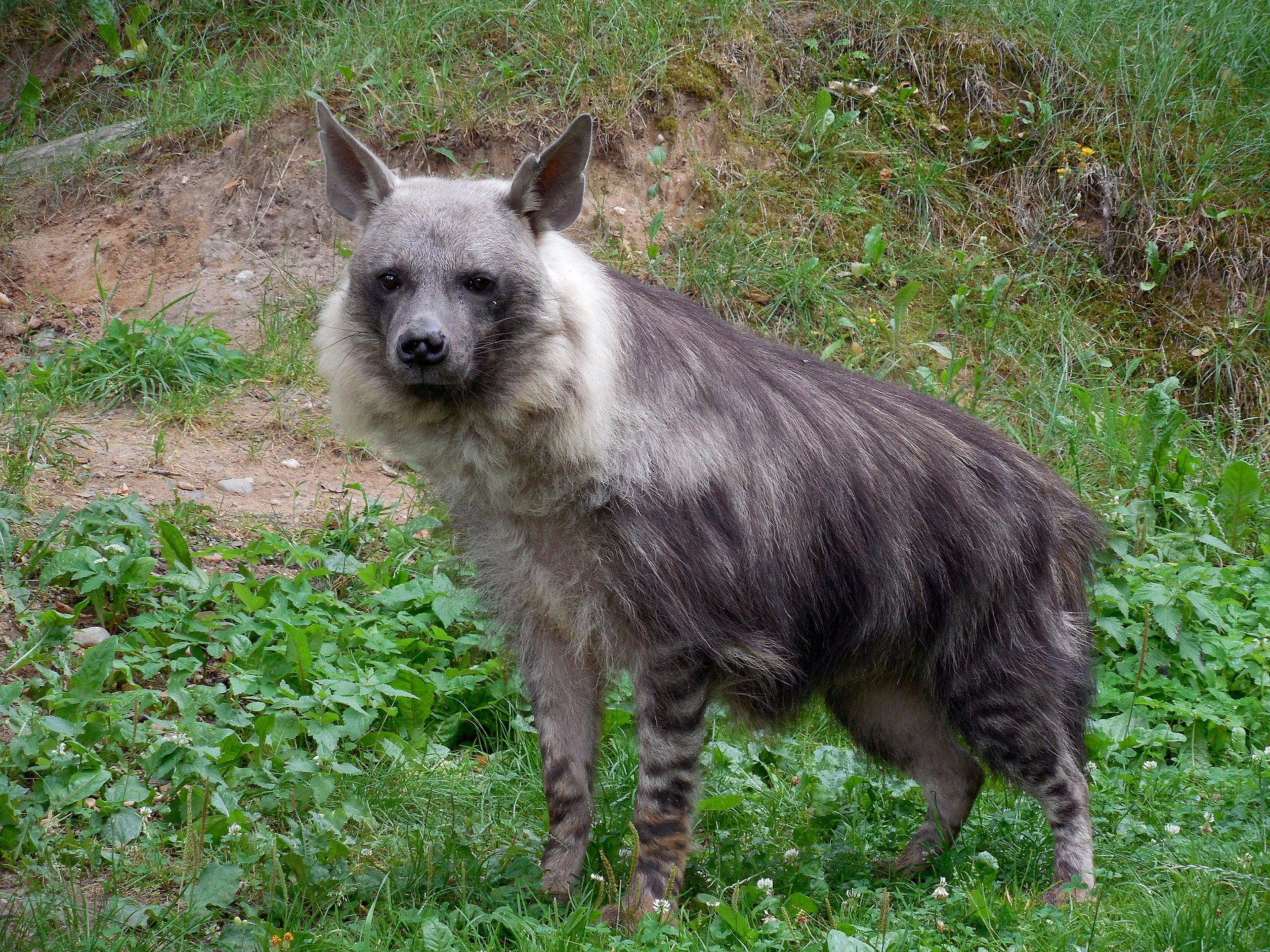
Like opossums, brown and striped hyenas can feign death when they are under attack. They can remain in this state for a long time, and it is an effective strategy when escape is impossible. Because some predators do not consume prey that is already dead, attackers may lose interest and leave them alone. Although striped hyenas can play dead, they will stand their ground against predators much larger than them if they are fighting over food.
They face fierce competition.
Hyenas are successful opportunistic predators, although they do face competition with other top predators. Lions are some of their toughest competitors due to the high similarity in their diets and ecological roles. Although there is a popular notion that hyenas steal the kills of lions, it is more common for lions to steal hyena kills. Lions typically are alert to the calls of hyenas and will follow their sound to attempt to steal their kills. The two species also seem to attack each other for no apparent reason.
Cheetahs and leopards also sometimes steal the kills of hyena whenever the opportunity strikes. Hyenas usually scare off cheetahs easily, but leopards can put on a fight for food. The hyenas often overpower leopards, however, due to their superior bite force and group hunting abilities. In one instance, two spotted hyenas killed and ate a young leopard in revenge for a young hyena the leopard killed.
Jackals and wolves are not much of a threat to hyenas, and they often ignore each other or even share kills. In some cases, striped hyenas may even live together with wolves, forming an unlikely alliance of predators. Hyenas are stronger and have a great sense of smell, while wolves can track large prey better than hyenas.
Other competitors of hyenas include African wild dogs, African rock pythons, caracals, red foxes, and tigers. In some areas, the territories of multiple hyena species overlap. Spotted hyenas usually attack the smaller species, although brown hyenas outnumber them in the Kalahari.
They rarely die from infectious diseases.
Infectious viral diseases such as distemper and rabies can sometimes kill populations of wild dogs, wolves, lions, and other carnivores. Among the most interesting hyena facts is that they rarely ever die from these deadly diseases. They show little to no deaths from diseases despite outbreaks in populations of nearby carnivores. Although this is an interesting feat, scientists know very little about the immune systems of hyenas.
Two hyena species are monogamous.
Striped hyenas either live alone or form monogamous pairs, although they may sometimes form small groups. They are not very territorial and can mate at any season of the year.
Aardwolves are also socially monogamous, although they are also likely to mate with other individuals outside their social pairs. They live together with their partners and will defend their territories together to ensure that their young can get enough food.
Some extinct hyenas sprinted like cheetahs.
Chasmaporthetes was a genus of hyenas that lived from 4.9 million to 780,000 years ago during the Pliocene-Pleistocene epochs. They were once successful predators, and one species, Chasmaporthetes ossifragus, even crossed the land bridges and lived in the Americas. Some scientists refer to the genus Chasmaporthetes as “running hyenas” because unlike dog-like hyenas and bone-crushing hyenas, they evolved into sprinters similar to cheetahs.
They typically hunt far from their territories.
Spotted hyenas can stay in large clans within a common territory because some groups of hyenas travel long distances away from their territories to hunt for prey. Researchers sometimes refer to this as a “commuting” system. Because of this system, hyenas are not just limited to the resources in their territories.
Ancient Egyptians used to tame striped hyenas to help them in hunting.
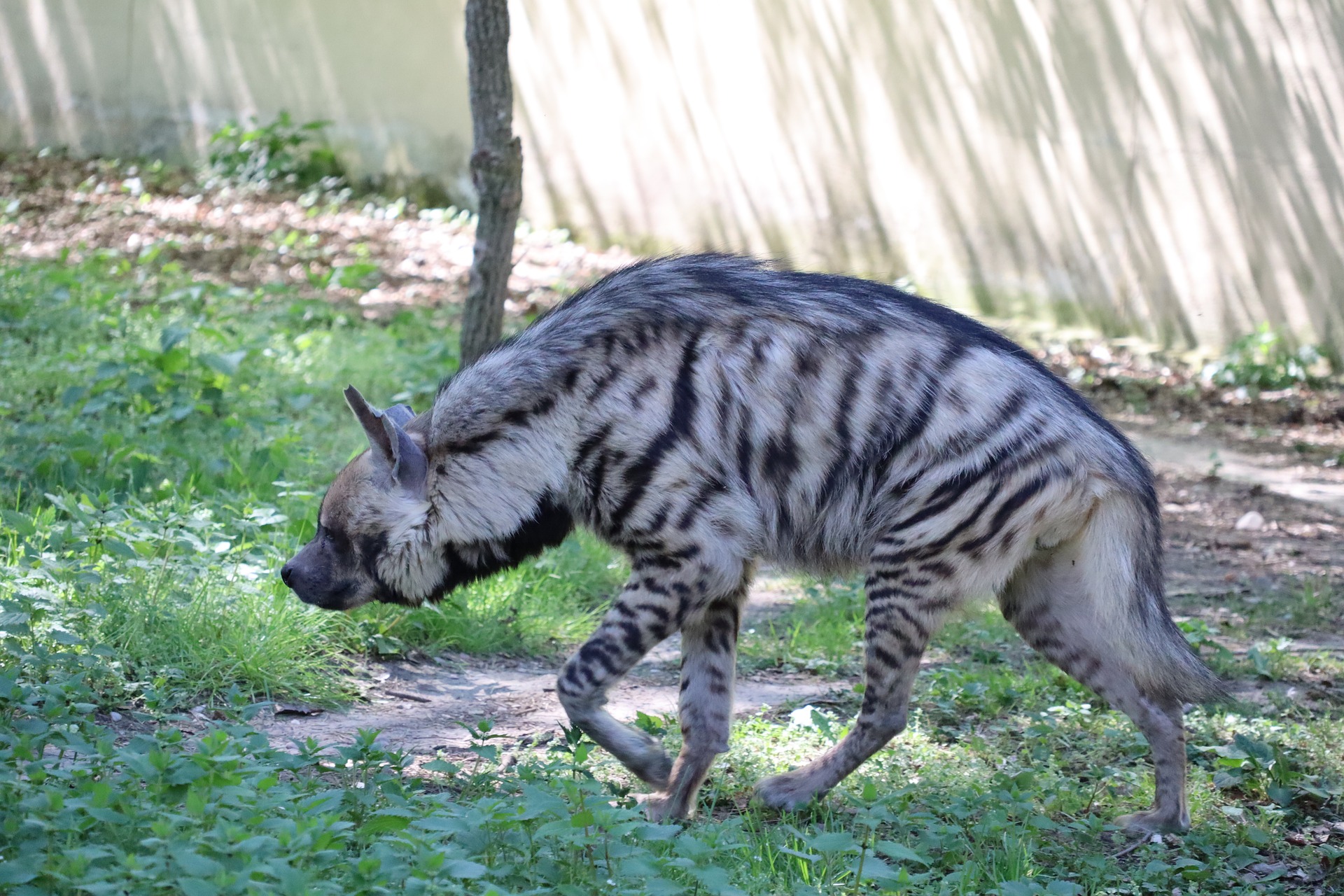
Striped hyenas are reportedly easy to tame and train, and the ancient Egyptians knew this. Ancient Egyptians tamed striped hyenas to help them in hunting, similar to hunting dogs. Striped hyenas can become quite affectionate and form bonds with humans and even dogs. The drawback, however, is that striped hyenas emit a strong odor that you cannot remove no matter how much you bathe them. How’s that for interesting hyena facts?
They are prominent in human culture.
Hyenas and humans have been dealing with each other since before recorded history, and a few cave paintings of early humans even feature these fierce scavengers. However, they are not as prominent in animal worship as mammoths, cave bears, and cave lions.
Many cultures associate hyenas with greed, cowardice, deceitfulness, dirty habits, and even witchcraft. In the folklore of the Mbugwe in Tanzania, all hyenas are supposedly the companions of witches and there are no truly wild hyenas. Some cultures view hyenas in a more positive light, however, and believe that hyenas were the first to bring out the Sun to warm the Earth. Others also believe that the feces of hyenas can help toddlers walk at an early age.
President Theodore Roosevelt had a pet hyena.
Theodore Roosevelt, the 26th president of the United States, is famous for having a menagerie of more than 40 animals in the White House. One of these animals was a pet hyena named Bill. Roosevelt was not a fan of hyenas, however, and viewed them as cowardly. Bill the hyena lived temporarily in the White House until Roosevelt decided to place him in the National Zoo where he would live for the rest of his life.
Hyenas can attack humans.
In the wild, hyenas tend to shy away from humans, but they become much bolder at night. When it is dark out, hyenas may follow humans closely, and in some cases, may attack them. There have been multiple records of man-eating hyenas, with one pair being responsible for the death of 27 humans. Hyenas may also attack biologists in Africa, forcing them to escape by climbing trees. These ferocious animals still reportedly attack humans, especially favoring children.
Clans of hyenas also now frequent urban areas, with the capital of Ethiopia reportedly having upwards of a thousand hyenas scavenging on human waste and hunting cats and dogs. There are also some attacks on homeless people, as well as an attack on a baby boy in 2013.
They may also dig up corpses.
Aside from attacking live humans, hyenas also tend to dig up and scavenge on human corpses. The African ethnic groups of the Maasai and the Hadza traditionally leave their corpses out in the open for hyenas to feed on. According to their beliefs, if hyenas refuse to feed on the corpses, then there must be something wrong with it. This usually leads to social disgrace, so they may often cover the bodies with ox blood and fat to entice hyenas to eat them. Hyenas notably scavenged on the corpses of humans during the Red Terror in Ethiopia, the Second Sudanese Civil War, and World War I.
Hyenas also attack livestock.
Aside from their attacks on humans and human graves, hyenas also pose a problem for livestock and pets. Wild hyenas may attack poultry, cattle, goats, and sheep. They may also attack dogs, horses, and donkeys. However, they are more likely to feed on livestock that are already dead. Putting up thorn fences can often suffice in deterring hyena attacks on livestock.
Humans hunt hyenas for various purposes.
Aside from hunting hyenas because of their tendency to attack humans and livestock, many also hunt hyenas for their perceived medicinal uses. In the traditional medicine of many cultures, hyenas supposedly hold magical or healing properties. Zoroastrian Magi believed that their body parts could cure diseases and even promote sexual desire in humans. Ancient Greeks and Romans also believed that the body parts of hyenas can effectively ward off evil.
Despite their supposed medicinal uses, the meat of hyenas is not usually desirable for human consumption. Even communities that eat unusual food items rarely feed on hyena meat. Trophy hunting of hyenas is also less common compared to the hunting of more charismatic species.
Even though humans occasionally hunt hyenas, they still seem to thrive in their respective habitats. This is due to the fact that hyenas are opportunistic and highly adaptable animals, and they are not picky about what they eat!
Was this page helpful?
Our commitment to delivering trustworthy and engaging content is at the heart of what we do. Each fact on our site is contributed by real users like you, bringing a wealth of diverse insights and information. To ensure the highest standards of accuracy and reliability, our dedicated editors meticulously review each submission. This process guarantees that the facts we share are not only fascinating but also credible. Trust in our commitment to quality and authenticity as you explore and learn with us.
